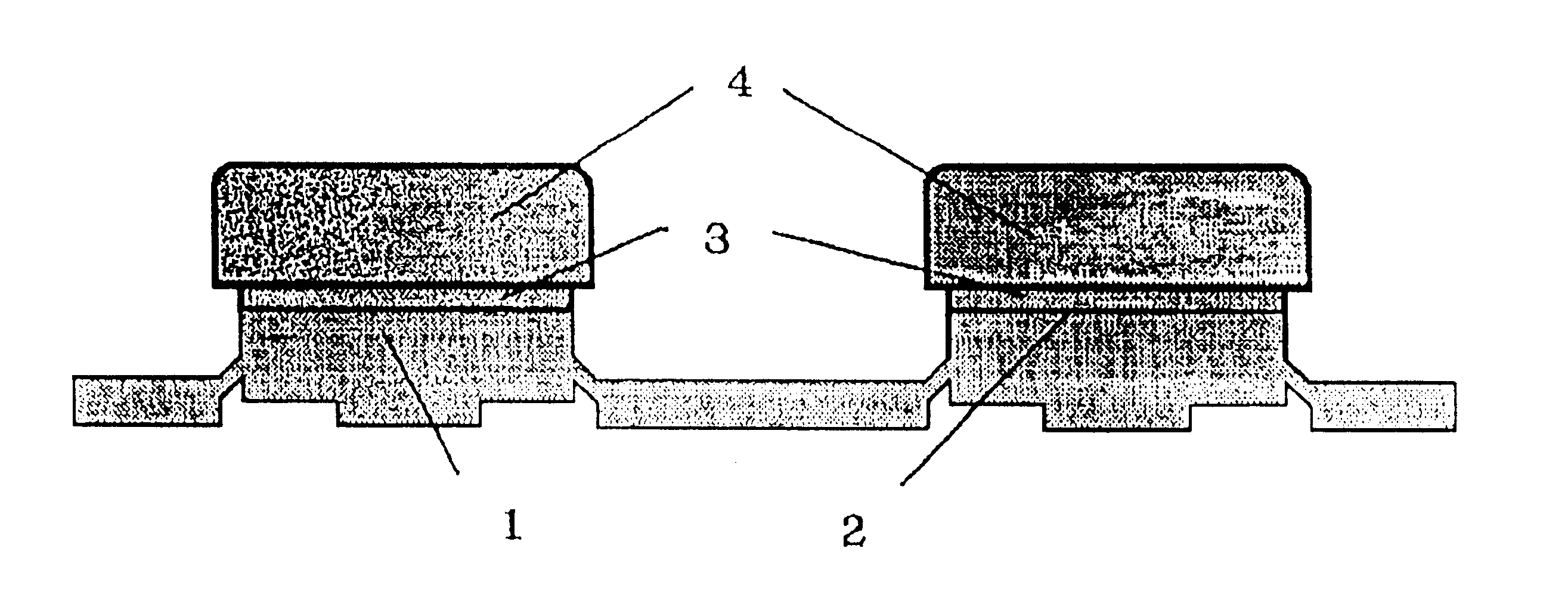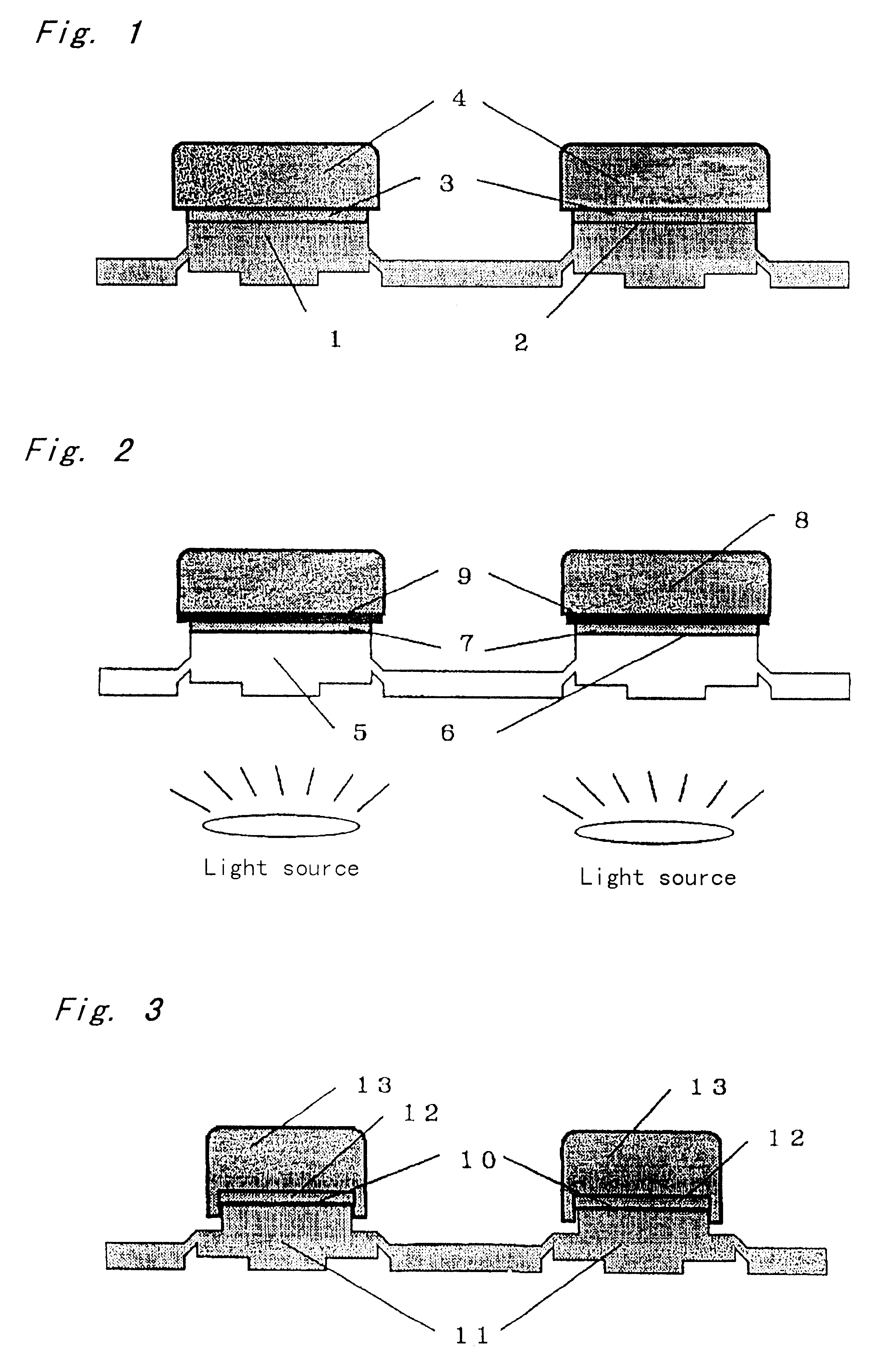Method for manufacturing key pad with rigid resin key top
a technology of rigid resin and key top, which is applied in the direction of adhesive types, contact mechanisms, chemical instruments and processes, etc., can solve the problems of increasing the time of adhesion process and the number of affixing jigs, low productivity and less economy, and improving the adhesion and compatibility of printing inks
- Summary
- Abstract
- Description
- Claims
- Application Information
AI Technical Summary
Benefits of technology
Problems solved by technology
Method used
Image
Examples
example 2
As shown in FIG. 2, the surface of a key pad 5 formed with silicone rubber compound (SH861 supplied by TORAY-Dow Corning Silicone Co., Ltd.) is altered by corona treatment. UV reactive hardening resin (3045 supplied by Three Bond Co., Ltd.) 7 is applied to a key top adhesion portion 6 of the key pad 5 by screen printing method. Graphic printing 9 is made with printing ink (Sericol 13 supplied by Teikoku Ink Co., Ltd.) on the back of a rigid resin key top 8 formed with translucent polycarbonate resin (Panlite L1 225L supplied by Teijin Kasei Co., Ltd.), then this rigid resin key top 8 and the key top adhesion portion 6 are adhered, and UV having main wavelength 365 nm is irradiated from the key pad side by the intensity of 1000 mW / cm2 for 15 seconds to adhere them.
example 3
As shown in FIG. 3, the surface of a key pad 11 formed using silicone rubber compound (SH861 supplied by TORAY-Dow Corning Silicone Co., Ltd.) and disposing irregularities for positioning on a key top adhesion portion 10 is irradiated by short wavelength UV to alter its surface. Towliquid type urethane base reactive hardening resin (7550 supplied by Lord Far East Incorporated) 12 is applied to the key top adhesion portion 10 of this key pad by the dispenser, and a rigid resin key top 13 molded with ABS resin (Diapet ABS VP-1, supplied by Mitsubishi Rayon Col., Ltd.) is fitted to the irregularities disposed on the key top adhesion portion 10, and hardened for 10 minutes at 80.degree. C. for adhesion.
example 4
As shown in FIG. 4, Graphic printing 16 is made with silicone ink (PRK-3 supplied by TORAY-Dow Corning Silicone Co., Ltd.) on a key top adhesion portion 15 of a key pad 5 formed with silicone rubber compound (SH861 supplied by TORAY-Dow Corning Silicone Co., Ltd.). The surface of this key pad is irradiated by short wavelength UV to alter. UV reactive hardening resin (3045 supplied by Three Bond Co., Ltd.) 17 is applied to a key top 15 by screen printing method. A rigid resin key top 18 formed with translucent acrylic resin (Acrylite L supplied by Mitsubishi Rayon Co., Ltd.) is adhered to the key top adhesion portion 15 by irradiating UV having main wavelength 365 nm from the key top side by the intensity of 1000 mW / cm.sup.2 for 15 seconds.
PUM
| Property | Measurement | Unit |
|---|---|---|
| pressure | aaaaa | aaaaa |
| wavelength | aaaaa | aaaaa |
| softening point | aaaaa | aaaaa |
Abstract
Description
Claims
Application Information
 Login to View More
Login to View More - R&D
- Intellectual Property
- Life Sciences
- Materials
- Tech Scout
- Unparalleled Data Quality
- Higher Quality Content
- 60% Fewer Hallucinations
Browse by: Latest US Patents, China's latest patents, Technical Efficacy Thesaurus, Application Domain, Technology Topic, Popular Technical Reports.
© 2025 PatSnap. All rights reserved.Legal|Privacy policy|Modern Slavery Act Transparency Statement|Sitemap|About US| Contact US: help@patsnap.com



